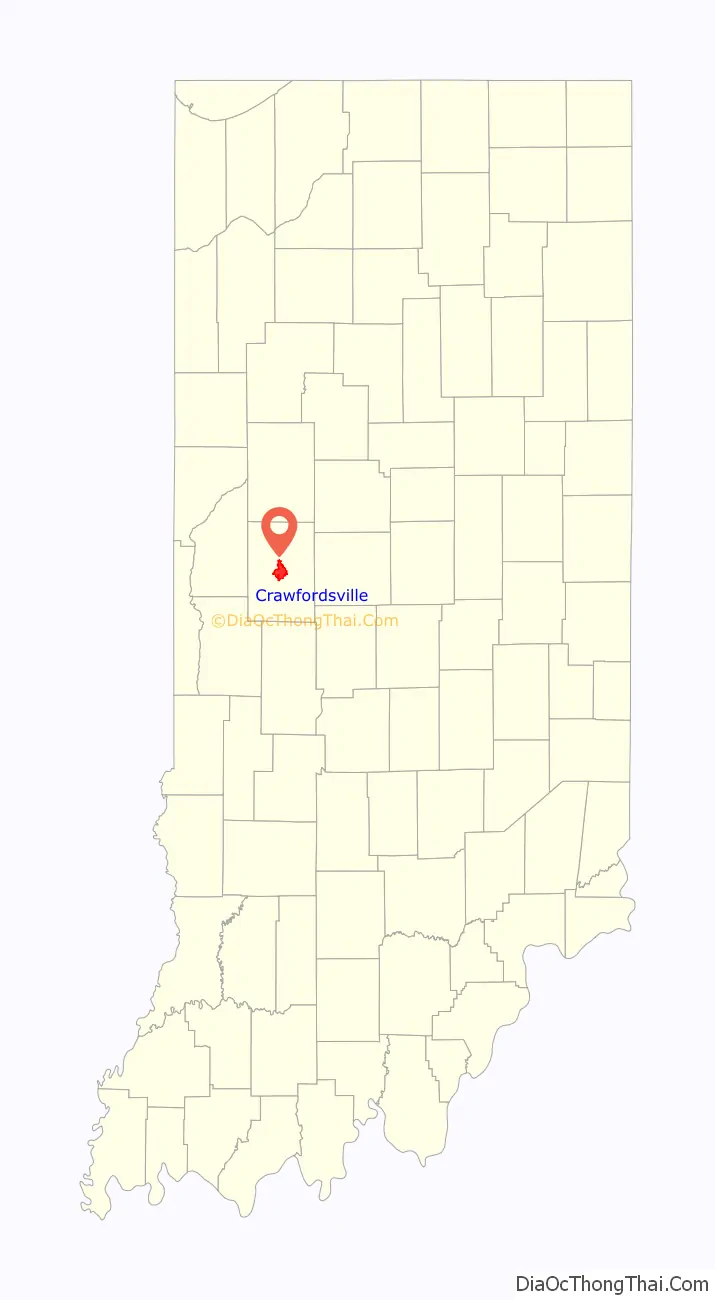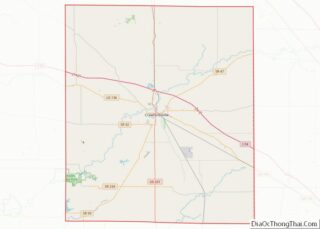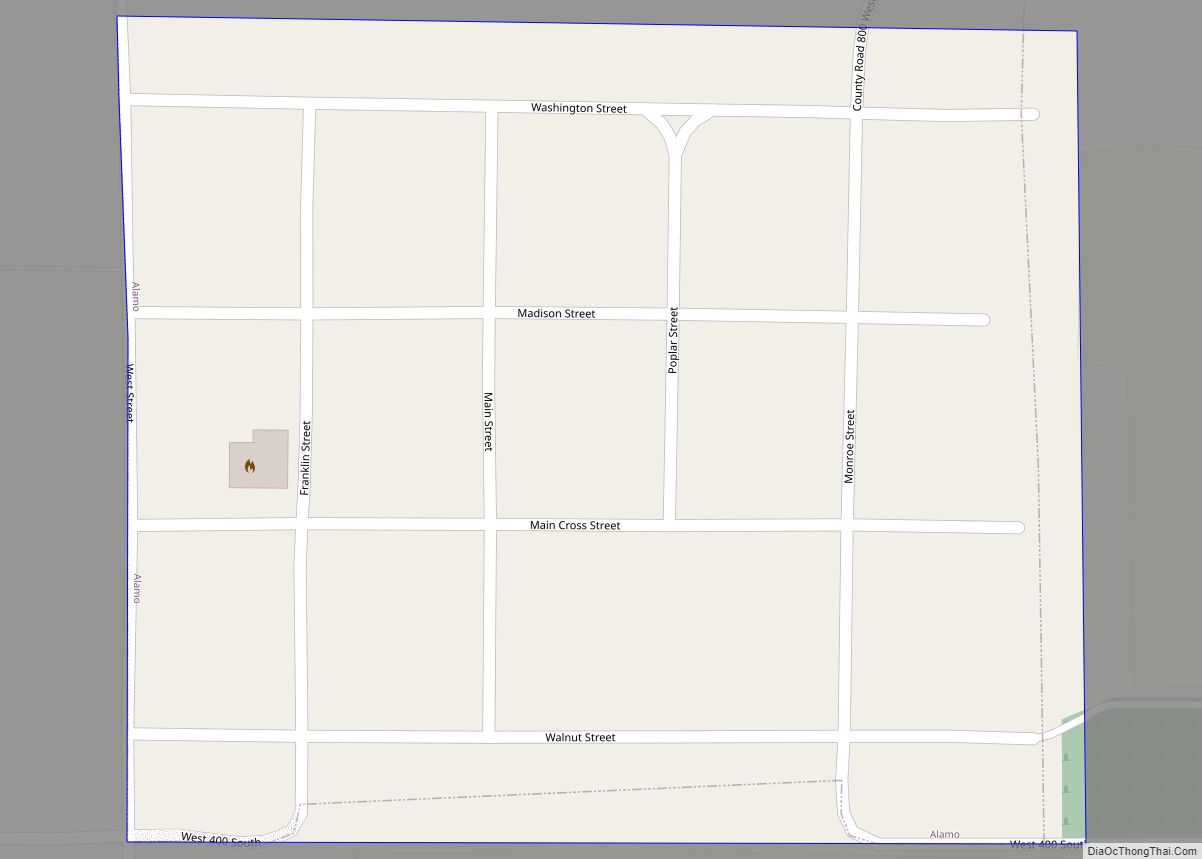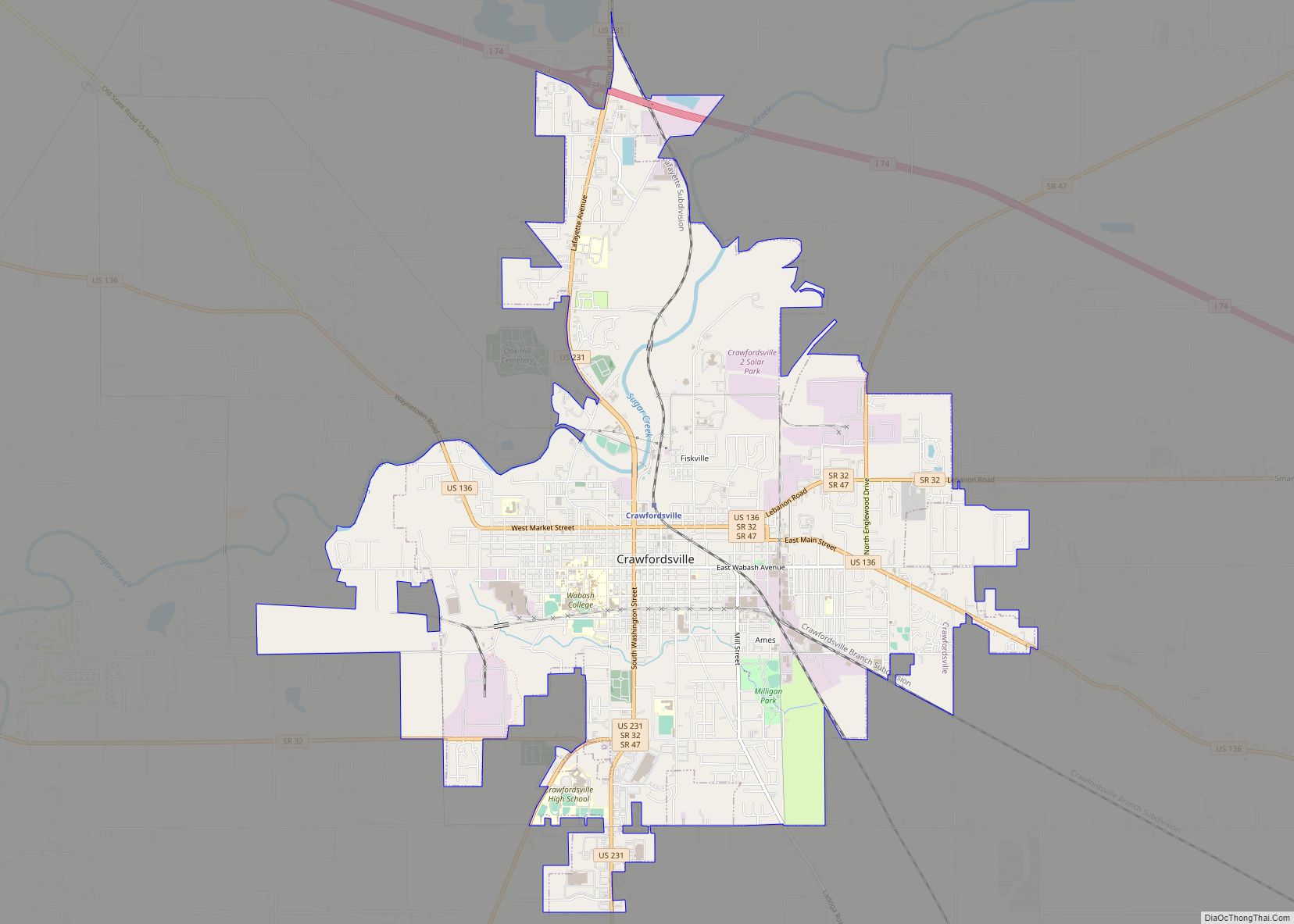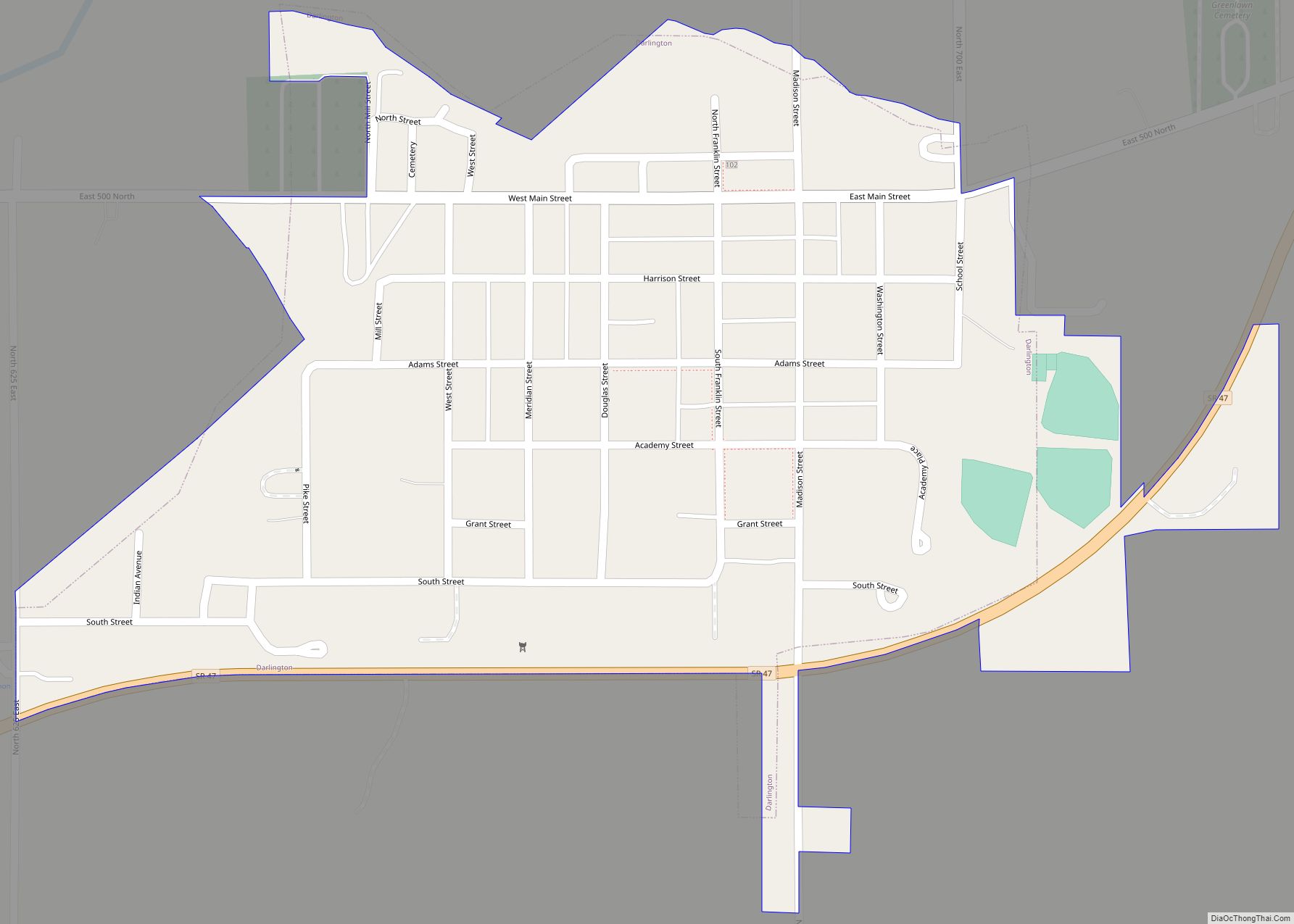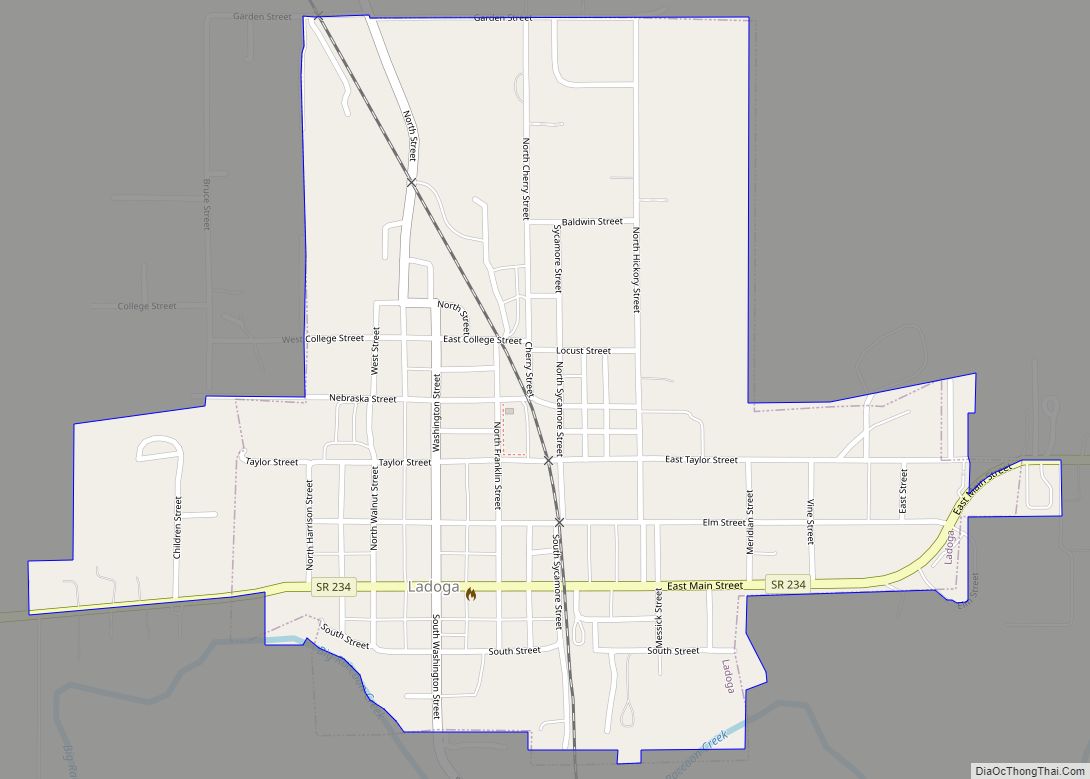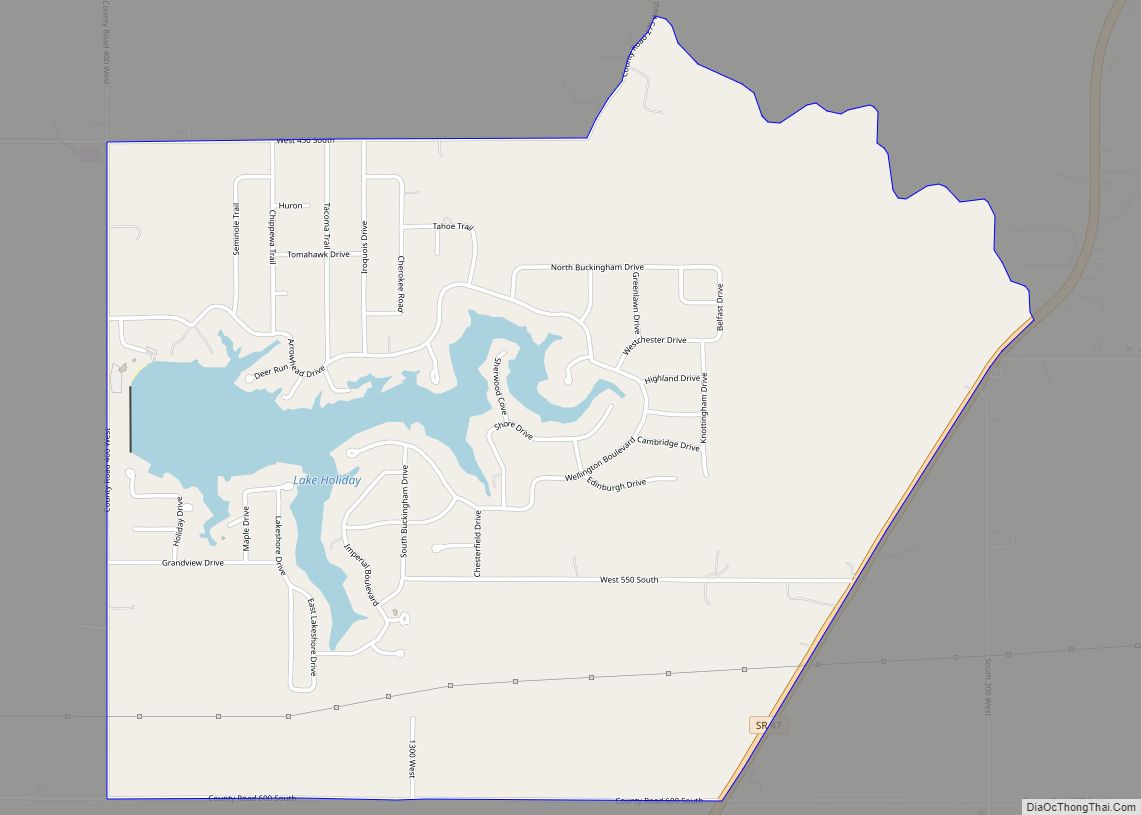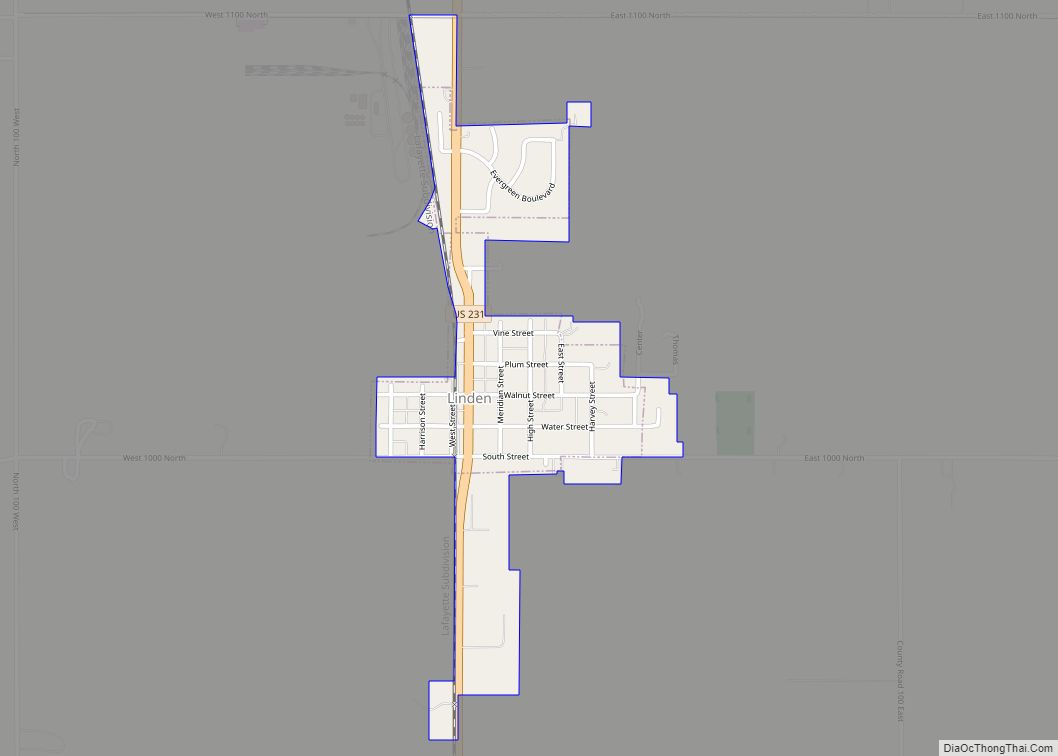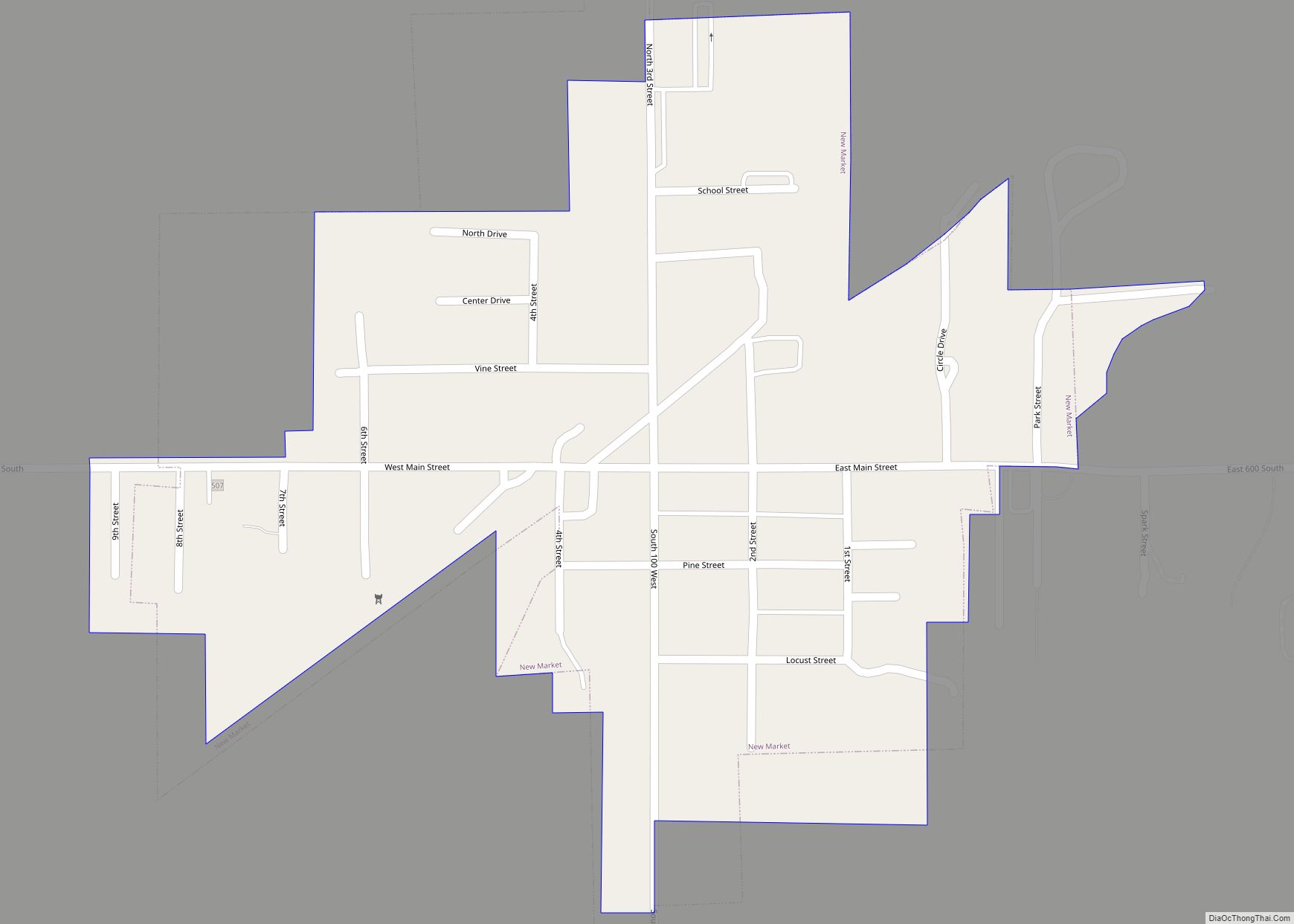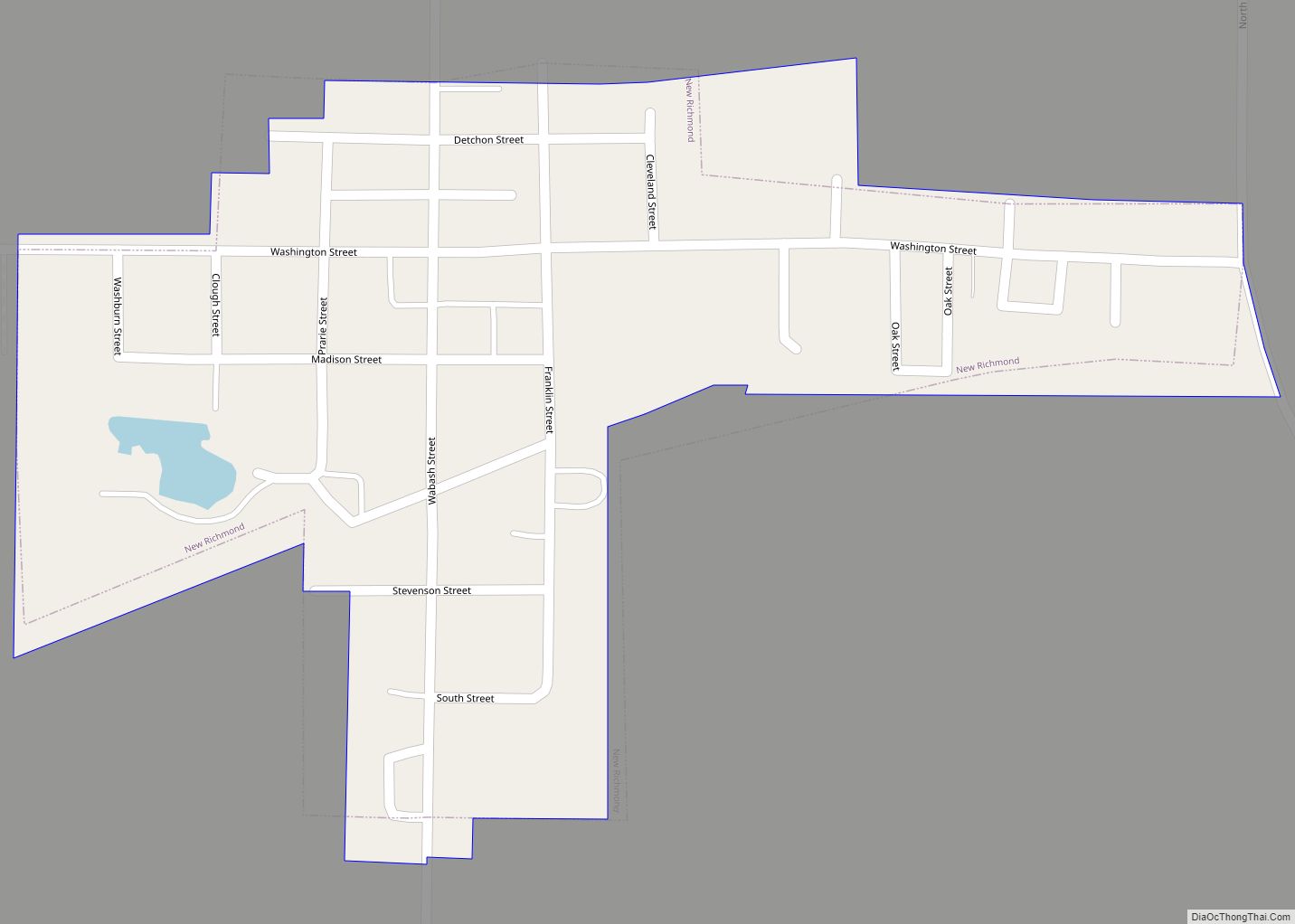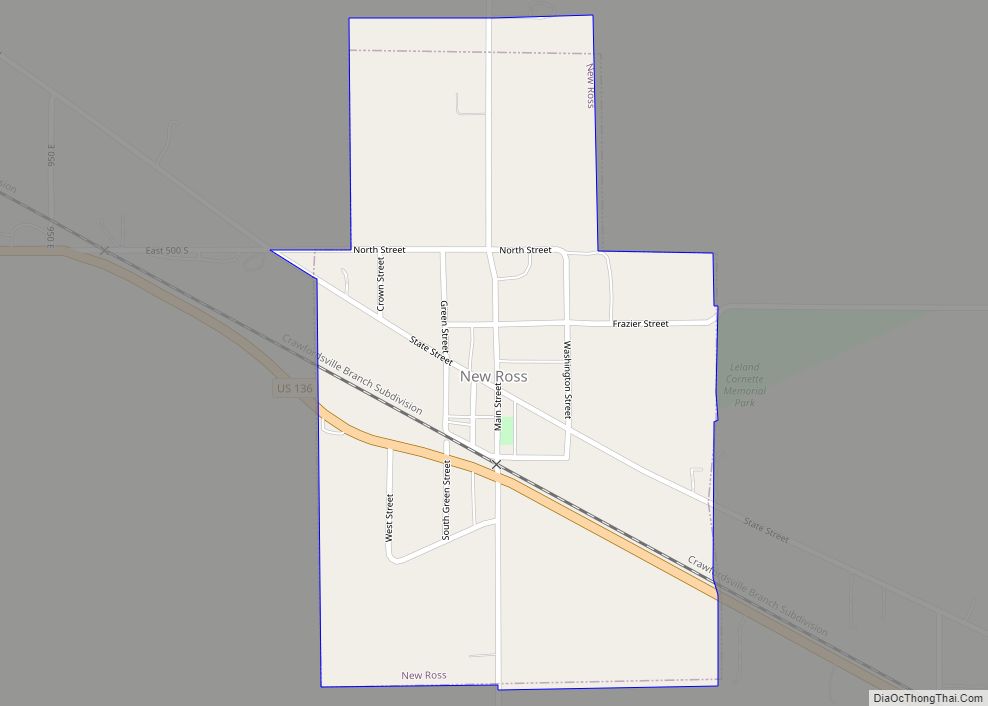Crawfordsville is a city in Montgomery County in west central Indiana, United States, 49 miles (79 km) west by northwest of Indianapolis. As of the 2020 census, the city had a population of 16,306. The city is the county seat of Montgomery County, the only chartered city and largest populated place in the county. Crawfordsville is part of a broader Indianapolis combined statistical area, although the Lafayette metropolitan statistical area is only 30 miles (48 km) north. It is home to Wabash College, which was ranked by Forbes as #12 in the United States for undergraduate studies in 2008.
The city was founded in 1823 on the bank of Sugar Creek, a southern tributary of the Wabash River and named for U.S. Treasury Secretary William H. Crawford.
| Name: | Crawfordsville city |
|---|---|
| LSAD Code: | 25 |
| LSAD Description: | city (suffix) |
| State: | Indiana |
| County: | Montgomery County |
| Elevation: | 794 ft (242 m) |
| Total Area: | 9.70 sq mi (25.11 km²) |
| Land Area: | 9.70 sq mi (25.11 km²) |
| Water Area: | 0.00 sq mi (0.00 km²) |
| Total Population: | 16,306 |
| Population Density: | 1,681.72/sq mi (649.30/km²) |
| ZIP code: | 47933-47939 |
| Area code: | 765 |
| FIPS code: | 1815742 |
| GNISfeature ID: | 433103 |
| Website: | crawfordsville.net |
Online Interactive Map
Click on ![]() to view map in "full screen" mode.
to view map in "full screen" mode.
Crawfordsville location map. Where is Crawfordsville city?
History
Early 19th century
In 1813, Williamson Dunn, Henry Ristine, and Major Ambrose Whitlock, U.S. Army, noted that the site of present-day Crawfordsville was ideal for settlement, surrounded by deciduous forest and potentially arable land, with water provided by a nearby creek, later named Sugar Creek, that was a southern tributary of the Wabash River. They returned a decade later to find at least one cabin had been built in the area. In 1821, William and Jennie Offield had built a cabin on a little creek, later to be known as Offield Creek, four miles (6.4 km) southwest of the future site of Crawfordsville.
Whitlock, a Virginian who had served under Gen. “Mad” Anthony Wayne in the Northwest Indian War, laid out the town in March 1823. Crawfordsville was named in honor of William H. Crawford, a fellow Virginian who was Secretary of the Treasury under Presidents Madison and Monroe at that time and who had issued Whitlock’s commission as Receiver of Public Lands. Whitlock was the first settler in the town.
According to a diary of Sanford C. Cox, who in 1824 was one of the first schoolmasters in the area, “Crawfordsville is the only town between Terre Haute and Fort Wayne… Maj. Ristine keeps tavern in a two-story log house and Jonathan Powers has a little grocery. There are two stores, Smith’s near the land office, and Issac C. Elston’s, near the tavern… David Vance [is the] sheriff.”
It was successfully incorporated as a town in 1834, following a failed attempt three years earlier.
In November 1832, Wabash College was founded in Crawfordsville as “The Wabash Teachers Seminary and Manual Labor College”. It was created by Presbyterian missionaries but later became non-sectarian. On December 18, 1833, the Crawfordsville Record carried a paid announcement of the opening of this school. The school is one of only three remaining all-male liberal arts colleges in the country and has a student body of around 900.
In 1842, 9-year-old Horace Hovey discovered remarkably well-preserved Pentacrinites or Crinoids along the banks of Sugar Creek, which drew researchers and fossil enthusiasts to the area.
Crawfordsville grew in size and amenities, adding such necessities as a bank and fire department. It gained status as a city in 1865, when the state of Indiana granted its charters.
Late 19th century
In 1862, Joseph F. Tuttle, after whom Tuttle Grade School was named in 1906 and Tuttle Junior High School (now Crawfordsville Middle School) was named in 1960, became president of Wabash College and served for 30 years. “He was an eloquent preacher, a sound administrator and an astute handler of public relations.” Tuttle, together with his administrators, worked to improve relations in Crawfordsville between “Town and Gown”.
Several future and past Civil War generals lived in Crawfordsville at different times. Generals Lew Wallace and Mahlon D. Manson spent most their lives in the town. Generals Edward Canby and John P. Hawkins spent some of their youth in Crawfordsville. General Henry B. Carrington lived in the town after the war and taught military science at Wabash College. Several other future generals were students at Wabash before the war, including Joseph J. Reynolds, John C. Black (brevet brigadier), Speed S. Fry, Charles Cruft, and William H. Morgan.
In 1880, prominent local citizen Lew Wallace produced Crawfordsville’s most famous literary work, Ben-Hur: A Tale of the Christ, a historical novel dealing with the beginnings of Christianity in the Mediterranean world. In addition to Wallace, Crawfordsville lived up to its nickname “The Athens of Indiana” by being the hometown of a number of authors, including Maurice Thompson, Mary Hannah Krout, Caroline Virginia Krout, Susan Wallace, Will H. Thompson, and Meredith Nicholson.
Hoosiers have long believed that the first basketball game in Indiana occurred on March 16, 1894 at the Crawfordsville YMCA between the teams from Crawfordsville’s and Lafayette’s YMCAs. Recent research, however, conclusively shows that while Crawfordsville was among the first dozen or so Indiana communities to adopt the sport, it was not the first place basketball was played in Indiana. Nevertheless, Crawfordsville had a vibrant basketball playing culture from early on with teams from the local YMCA, Wabash College, Crawfordsville High School, and a business college competing against each other. Crawfordsville was also the site for one of the earliest intercollegiate basketball games, between Wabash College and Purdue University, in 1894 at the city’s YMCA.
In 1882, one of the first rotary jails in the country opened. It served from 1882 until 1972. The Montgomery County Jail and Sheriff’s Residence is now a museum and listed on the National Register of Historic Places.
20th century
The beginning of the 20th century marked important steps for Crawfordsville, as Culver Union Hospital and the Carnegie Library were built in 1902. Culver operated as a not-for-profit, municipally-owned facility for 80 years, but was then sold to for-profit American Medical International, and in 1984 was relocated from its original location near downtown to a new campus north of the city. The hospital’s ownership was transferred to Sisters of St. Francis Health Services, Inc. in 2000 and renamed St. Clare Medical Center. In 2011, it was again renamed, to Franciscan St. Elizabeth Health – Crawfordsville. In 1911, Crawfordsville High School was founded, and promptly won the state’s first high school basketball title. Crawfordsville’s major employer for much of the century, commercial printer RR Donnelley, began operations in Crawfordsville in 1922.
Recent history has held few nationally noteworthy events for the city but much internal change. Nucor Steel, Alcoa CSI, Raybestos Products Company, Pace Dairy Foods, and Random House have all created factories in or near Crawfordsville which provided employment to much of the population. Manpower has taken over as the primary employer in the city and has allowed most of the local companies to reduce employees. In 2008, Raybestos laid off the majority of its workforce with less than 100 employees left. Wabash College won the Division III NCAA basketball title in 1982. The college plays an annual football game against Depauw University for the Monon Bell, one of the oldest rivalries in all college sports. In 1998, the state began a proposed project to widen U.S. Route 231, in an attempt to ease intrastate travel flow.
21st century
In 2005, the Crawfordsville District Public Library moved into a new building across the street from the city’s Carnegie library. The library retained ownership of the old building and re-opened it as the Carnegie Museum of Montgomery County in 2007.
On May 8, 2007, approximately a quarter-block of historic buildings in the 100 block of South Washington Street was burned in a major fire. A woman in one of the buildings reported the fire. One person, Leslie Eric Largent, died in the fire. The fire was covered by the press statewide. Two buildings, built circa 1882, were completely destroyed: one housed the Silver Dollar Bar (formerly Tommy Kummings’ Silver Dollar Tavern); the other contained the New York Shoe Repair and Bargain Center at the corner of Pike and Washington streets. Above the shoe store were several apartments where residents were sleeping. On May 22, the fire was ruled to have been an act of arson.
In 2015, Crawfordsville won a Stellar Community grant from Indiana Office of Community & Rural Affairs.
On May 17, 2018, a new clock tower built by Kentucky-based Campbellsville Industries was put into place on the courthouse’s original clock tower base. The original clock tower had been taken down in 1941 due to structural concerns. The clock tower was made possible by the Montgomery County Courthouse Clock Tower Committee and its fundraising efforts spanning more than twenty years. The clock tower was dedicated on June 17, and the bells and chimes were sounded for the first time.
National Register of Historic Places
As of 2016, Crawfordsville has twelve properties listed on the National Register of Historic Places. Three of the properties are currently museums: Gen. Lew Wallace Study, Henry S. Lane House, and Montgomery County Jail and Sheriff’s Residence. Two of the properties are historic districts: Crawfordsville Commercial Historic District, and Elston Grove Historic District. Two listings are active churches: Bethel AME Church of Crawfordsville, and Saint John’s Episcopal Church. The others properties are currently used as a law office (Otto Schlemmer Building), senior apartments and recreation center (Crawfordsville High School), a private residence (McClelland-Layne House), the headquarters of the local Daughters of the American Revolution chapter (Col. Isaac C. Elston House), and a former hospital renovated for senior apartments Culver Union Hospital.
Crawfordsville Road Map
Crawfordsville city Satellite Map
Geography
Crawfordsville is located at 40°2′20″N 86°53′48″W / 40.03889°N 86.89667°W / 40.03889; -86.89667 (40.038831, −86.896755). According to the 2010 census, Crawfordsville has a total area of 9.15 square miles (23.70 km), all land. Crawfordsville is located in west-central Indiana, about an hour west-northwest of Indianapolis, the state’s capital and largest city. While the Crawfordsville Micropolitan Area is not yet formally a part of the Indianapolis metropolitan area, it is considered a part of the wider Indianapolis Consolidated Metropolitan Statistical Area and the Indianapolis marketing area.
See also
Map of Indiana State and its subdivision:- Adams
- Allen
- Bartholomew
- Benton
- Blackford
- Boone
- Brown
- Carroll
- Cass
- Clark
- Clay
- Clinton
- Crawford
- Daviess
- De Kalb
- Dearborn
- Decatur
- Delaware
- Dubois
- Elkhart
- Fayette
- Floyd
- Fountain
- Franklin
- Fulton
- Gibson
- Grant
- Greene
- Hamilton
- Hancock
- Harrison
- Hendricks
- Henry
- Howard
- Huntington
- Jackson
- Jasper
- Jay
- Jefferson
- Jennings
- Johnson
- Knox
- Kosciusko
- LaGrange
- Lake
- Lake Michigan
- LaPorte
- Lawrence
- Madison
- Marion
- Marshall
- Martin
- Miami
- Monroe
- Montgomery
- Morgan
- Newton
- Noble
- Ohio
- Orange
- Owen
- Parke
- Perry
- Pike
- Porter
- Posey
- Pulaski
- Putnam
- Randolph
- Ripley
- Rush
- Saint Joseph
- Scott
- Shelby
- Spencer
- Starke
- Steuben
- Sullivan
- Switzerland
- Tippecanoe
- Tipton
- Union
- Vanderburgh
- Vermillion
- Vigo
- Wabash
- Warren
- Warrick
- Washington
- Wayne
- Wells
- White
- Whitley
- Alabama
- Alaska
- Arizona
- Arkansas
- California
- Colorado
- Connecticut
- Delaware
- District of Columbia
- Florida
- Georgia
- Hawaii
- Idaho
- Illinois
- Indiana
- Iowa
- Kansas
- Kentucky
- Louisiana
- Maine
- Maryland
- Massachusetts
- Michigan
- Minnesota
- Mississippi
- Missouri
- Montana
- Nebraska
- Nevada
- New Hampshire
- New Jersey
- New Mexico
- New York
- North Carolina
- North Dakota
- Ohio
- Oklahoma
- Oregon
- Pennsylvania
- Rhode Island
- South Carolina
- South Dakota
- Tennessee
- Texas
- Utah
- Vermont
- Virginia
- Washington
- West Virginia
- Wisconsin
- Wyoming

